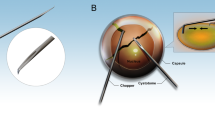Abstract
Purpose
To compare the intraoperative efficiency and postoperative visual outcome of coaxial phacoemulsification using 2.2- and 2.8-mm clear corneal incision coaxial phacoemulsification.
Setting
The study was conducted at Vardhaman Mahavir Medical College and Safdarjung Hospital, New Delhi which is a tertiary health care centre.
Study design
This is a prospective, randomized, comparative interventional study.
Materials and methods
A total of 140 eyes of patients undergoing cataract surgery were enrolled according to the inclusion–exclusion criteria and randomly divided in two groups of 70 such that Group I—Patients underwent phacoemulsification through 2.8-mm clear corneal incision. Group II—Patients underwent phacoemulsification through 2.2-mm clear corneal incision.Postoperative assessment was done at 1 day, 1 and 6 weeks to note best-corrected visual acuity (BCVA), ophthalmic examination, corneal topography, central corneal thickness and corneal endothelial cell count.
Statistics
1. Quantitative variables were compared using Mann–Whitney test and Wilcoxon ranked-sum test. 2. Qualitative variables were compared using Fisher’s exact test. p value of <0.05 was considered statistically significant.
Results
There is steady trend in decrease in postoperative astigmatism with time, more so in 2.8 mm group; however, differences were not found to be statistically significant. 2.2 mm group had larger increase in CCT and ECC compared to 2.8 mm group which was not statistically significant (p = 0.296).
Conclusion
Reducing the incision size from 2.8 to 2.2 mm does not result in any significant reduction in the amount of surgically induced astigmatism. Also, both the incision sizes have similar intraoperative efficacy when compared in terms of postoperative decrease in corneal endothelial cell count and increase in central corneal thickness.
Similar content being viewed by others
References
Alió J, Rodríguez-Prats JL, Galal A, Ramzy M (2005) Outcomes of microincision cataract surgery versus coaxial phacoemulsification. Ophthalmology 112:1997–2003
Chee SP, Bacsal K (2005) Endophthalmitis after microincision cataract surgery. J Cataract Refract Surg 31:1834–1835
Elkady B, Alió J, Ortiz D, Montalbán R (2008) Corneal aberrations after microincision cataract surgery. J Cataract Refract Surg 34:40–45
Yao K, Tang X, Ye P (2006) Corneal astigmatism, high order aberrations, and optical quality after cataract surgery: microincision versus small-incision. J Refract Surg 22:S1079–S1082
Jiang Y, Le Q, Yang J, Lu Y (2006) Changes in corneal astigmatism and high order aberrations after clear corneal tunnel phacoemulsification guided by corneal topography. J Refract Surg 22:S1083–S1088
Elkady B, Piñero D, Alió JL (2009) Corneal incision quality in microincisional cataract surgery (MICS) versus microcoaxial phacoemulsification. J Cataract Refract Surg 35:466–474
Berdahl JP, DeStafeno JJ, Kim T (2007) Corneal wound architecture and integrity after phacoemulsification: evaluation of coaxial, microincision coaxial, and microincision bimanual techniques. J Cataract Refract Surg 33:510–515
Osher RH, Injev VP (2006) Thermal study of bare tips with various system parameters and incision sizes. J Cataract Refract Surg 32:867–872
Behrens A, Stark WJ, Pratzer KA, McDonnell PJ (2008) Dynamics of small-incision clear cornea wounds after phacoemulsification surgery using optical coherence tomography in the early postoperative period. J Refract Surg 24:46–49
Alio JL, Rodriguez Prats JL, Galal A (2004) MICS: micro-incision cataract surgery. Highl Ophthalmol 1:1–4
Herretes S, Stark WJ, Pirouzmanesh A, Reyes JMG, McDonnell PJ, Behrens A (2005) Inflow of ocular surface fluid into the anterior chamber after phacoemulsification through sutureless corneal cataract wounds. Am J Ophthalmol 140:737–740
Taban M, Sarayba MA, Ignacio TS, Behrens A, McDonnell PJ (2005) Ingress of india ink into the anterior chamber through sutureless clear corneal cataract wounds. Arch Ophthalmol 123:643–648
Tsuneoka H, Shiba T, Takahashi Y (2001) Feasibility of ultrasound cataract surgery with a 1.4 mm incision. J Cataract Refract Surg 27:934–940
Chylack LT, Wolfe JK, Singer DM et al (1993) The lens opacities classification system III. Arch Ophthalmol 111(6):831–836
Fine IH, Packer M, Hoffman RS (2002) New phacoemulsification technologies. J Cataract Refract Surg 28(6):1054–1060
Guirao A, Tejedor J, Artal P (2004) Corneal aberrations before and after small-incision cataract surgery. Invest Ophthalmol Vis Sci 45:4312–4319
Hashemi H, Zandvakil N, Rahimi F, Beheshtnejad AH, Kheirkhah A (2010) Clinical comparison of conventional coaxial phacoemulsification and coaxial microincision phacoemulsification. Iran J Ophthal 22:13–24
Luo L, Lin H, He Minguuag et al (2012) Clinical evaluation of three incision size-dependent phacoemulsification systems. Am J Ophthalmol 153:831–839
Nielsen PJ (1995) Prospective evaluation of surgically induced astigmatism and astigmatic keratotomy effects of various self-sealing small incisions. J Cataract Refract Surg 21(1):43–48
Beltrame G, Salvetat ML, Chizzolini M, Driussi G (2001) Corneal topographic changes induced by different oblique cataract incisions. J Cataract Refract Surg 27(5):720–727
Lesiewska-Junk H, Kałuzny J, Malukiewicz-Wiśniewska G (2002) Long-term evaluation of endothelial cell loss after phacoemulsification. Eur J Ophthalmol 12(1):30–33
Bourne WM, Nelson LR, Hodge DO (1994) Continued endothelial cell loss ten years after lens implantation. Ophthalmology 101(6):1014–1022
Hayashi K, Yoshida M, Hayashi H (2009) Postoperative corneal shape changes: microincision versus small-incision coaxial cataract surgery. J Cataract Refract Surg 35:233–239
Berdahl JP, Jun B, DeStafeno JJ, Kim T (2008) Comparison of a torsional handpiece through microincision versus standard clear corneal cataract wounds. J Cataract Refract Surg 34(12):2091–2095
Dosso AA, Cottet L, Burgener ND, Di Nardo S (2008) Outcomes of coaxial microincision cataract surgery versus conventional coaxial cataract surgery. J Cataract Refract Surg 34(2):284–288
Cheng H, Bates AK, Wood L et al (1988) Positive correlation of corneal thickness and endothelial cell loss. Serial measurements after cataract surgery. Arch Ophthalmol 106:920–922
Glasser DB, Matsuda M, Ellis JG et al (1985) Effects of intraocular irrigating solutions on the corneal endothelium after in vivo anterior chamber irrigation. Am J Ophthalmol 99:321–328
Kiss B, Findl O, Menapace R et al (2003) Corneal endothelial cell protection with a dispersive viscoelastic material and a irrigating solution during phacoemulsification. Low-cost versus expensive combination. J Cataract Refract Surg 29:733–740
Author information
Authors and Affiliations
Corresponding author
Rights and permissions
About this article
Cite this article
Sethi, H.S., Saluja, K. & Naik, M.P. Comparative analysis of coaxial phacoemulsification with 2.2- and 2.8-mm clear corneal incisions. Int Ophthalmol 38, 215–222 (2018). https://doi.org/10.1007/s10792-017-0450-5
Received:
Accepted:
Published:
Issue Date:
DOI: https://doi.org/10.1007/s10792-017-0450-5




